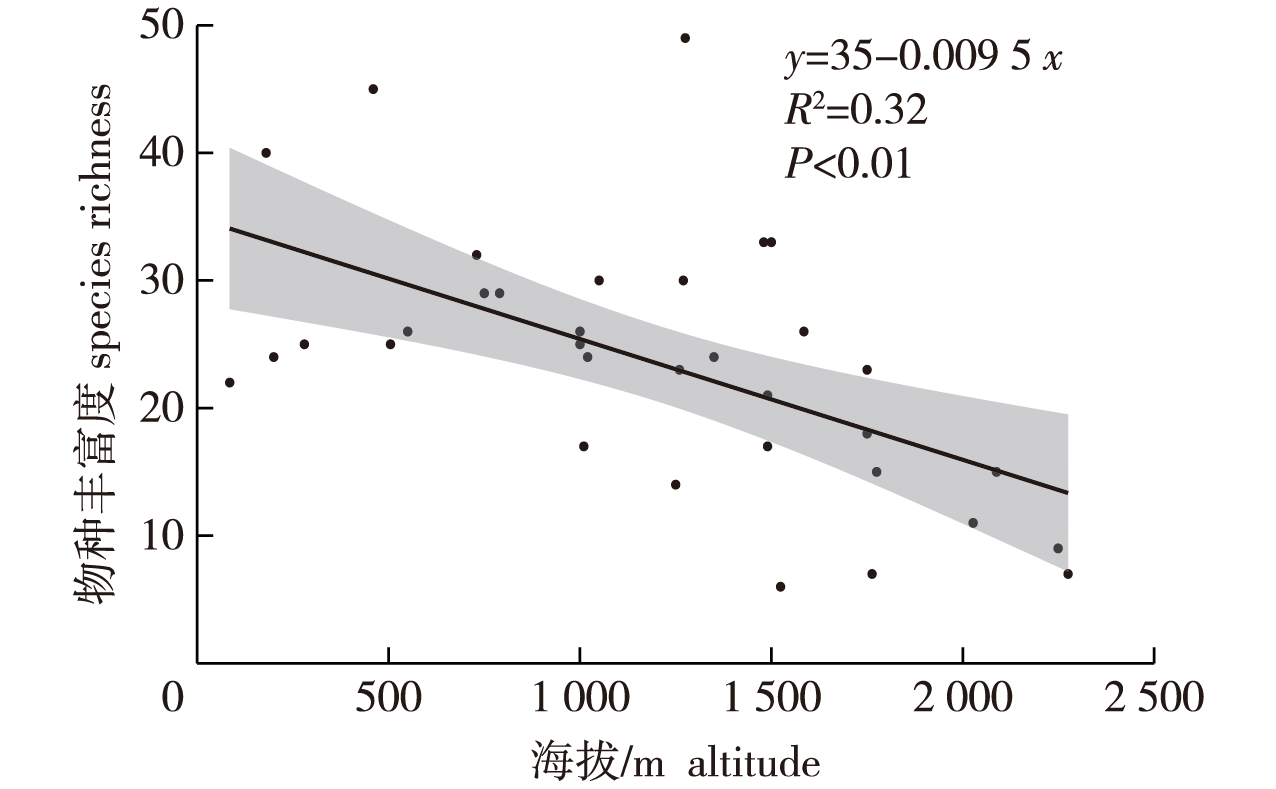 PDF(2570 KB)
PDF(2570 KB)


Distribution patterns of ant species in southeastern Yunnan Province
YANG Lin, ZHU Huiqin, XU Zhenghui, ZHANG Xinmin, ZHOU Xueying, XU Guolian, LIU Xia
Journal of Nanjing Forestry University (Natural Sciences Edition) ›› 2024, Vol. 48 ›› Issue (5) : 204-210.
 PDF(2570 KB)
PDF(2570 KB)
 PDF(2570 KB)
PDF(2570 KB)
Distribution patterns of ant species in southeastern Yunnan Province
【Objective】The study aimed to investigate the patterns and laws of ant species distribution, including the habitat, vertical distribution, foraging patterns and nesting sites in southeastern Yunnan Province, provide a scientific basis for biodiversity cataloging and protection in this area.【Method】The distribution patterns of ant species in southeastern Yunnan Province were investigated using the plot-sampling method, and the data were counted using the harvesting frequency method. The Pearson correlation between the altitude and species richness of the ants was analyzed using the SPSS 26 software. 【Result】 A total of 197 species of ants, belonging to 64 genera and nine subfamilies under the Formicidae family, were recorded from five vertical zones in southeastern Yunnan Province. The majority of ant species inhabited different vegetation zones; however, a few ants, including Aphaenogaster schurri and Lasius himalayanus, inhabited only a single vegetation type. Of the 13 habitats, the ants (87 species) were most abundant in the middle-and low-altitude monsoon evergreen broadleaf forest, and least abundant (eight species) in the high-altitude Quercus semicarpifolia forest. The majority of ant species had a narrow ecological adaptation range, and the height difference in vertical distribution was less than 500 m. A few species of ants, including Ectomomyrmex javana, Nylanderia flavipes, and others exhibited a wide ecological adaptation range, and the height difference in vertical distribution was greater than 2 000 m. There were differences in the foraging zones and nesting sites of the majority of ant species. A few species, including Crematogaster osakensis, Formica cunicularia and Dolichoderus taprobanae, foraged and nested in multiple sites, and the species that foraged on the ground and nested in the soil were the most abundant. Correlation analysis revealed that the altitude and species richness were significantly negatively correlated at 0.01 level of significance. 【Conclusion】There are abundant resource for ant populations in southeastern Yunnan Province, and the distribution patterns of ant species in the region are primarily related to the altitude, types of vegetation, and adaptability. The species richness was found to be high in the middle-and low-altitude areas, which have a hot and humid climate, rich vegetation types, and sufficient food resources and nesting sites; however, the ants in the high-altitude areas inhabited fewer habitats and their species richness was low due to the cold climate and single type of vegetation. The study revealed that the functional characteristics of the ants determine their viability. The majority of ant species exhibited a strict environmental selection, and there were obvious differences in the distribution patterns of different species.

Formicidae species / vertical distribution / habitat / foraging place / nesting site
| [1] |
|
| [2] |
徐正会. 西双版纳自然保护区蚁科昆虫生物多样性研究[M]. 昆明: 云南科技出版社, 2002.
|
| [3] |
|
| [4] |
李巧, 卢志兴, 张威, 等. 金沙江干热河谷人工林地表的蚂蚁群落[J]. 林业科学, 2015, 51(8):134-142.
|
| [5] |
长有德, 贺达汉. 中国西北地区蚂蚁区系特征[J]. 动物学报, 2002, 48(3):322-332.
|
| [6] |
郭萧, 徐正会, 杨俊伍, 等. 滇西北云岭东坡蚂蚁物种多样性研究[J]. 林业科学研究, 2007, 20(5):660-667.
|
| [7] |
黄钊, 徐正会, 刘霞, 等. 滇东北地区的蚂蚁物种多样性[J]. 生态学杂志, 2019, 38(12):3697-3705.
|
| [8] |
诸慧琴, 徐正会, 和玉成, 等. 滇东南地区蚂蚁群落结构研究[J]. 湖北农业科学, 2020, 59(5):113-120.
|
| [9] |
诸慧琴, 徐正会, 张新民, 等. 滇东南地区的蚂蚁物种多样性[J]. 环境昆虫学报, 2019, 41(3):533-544.
|
| [10] |
郭宁妍, 钱昱含, 徐正会, 等. 滇西南地区蚂蚁物种多样性研究[J]. 西南农业学报, 2021, 34(8):1728-1739.
|
| [11] |
郭宁妍, 房华, 徐正会, 等. 滇西南地区蚁科昆虫区系分析[J]. 云南农业大学学报(自然科学), 2022, 37(5):729-742.
|
| [12] |
郭宁妍, 钱昱含, 徐正会, 等. 滇西南地区蚂蚁物种分布格局研究[J]. 云南农业大学学报(自然科学), 2022, 37(1):10-23.
|
| [13] |
莫福燕, 徐正会, 宋扬, 等. 喜马拉雅山亚东段蚂蚁群落研究[J]. 南京林业大学学报(自然科学版), 2015, 39(3):85-90.
|
| [14] |
徐正会, 褚姣娇, 张成林, 等. 藏东南工布自然保护区的蚂蚁种类及分布格局[J]. 四川动物, 2011, 30(1):118-123.
|
| [15] |
|
| [16] |
吴坚, 王常禄. 中国蚂蚁[M]. 北京: 中国林业出版社, 1995.
|
| [17] |
罗成龙, 徐正会, 熊忠平, 等. 四川王朗自然保护区及邻近地区蚂蚁物种的分布格局[J]. 浙江农林大学学报, 2019, 36(4):638-645.
|
| [18] |
徐正会, 曾光, 柳太勇, 等. 西双版纳地区不同植被亚型蚁科昆虫群落研究[J]. 动物学研究, 1999, 20(2):118-125.
|
| [19] |
陈超, 熊忠平, 徐正会, 等. 青藏高原东北坡蚂蚁物种的分布格局[J]. 林业科学研究, 2022, 35(3):131-140.
|
| [20] |
沈梦伟, 陈圣宾, 毕孟杰, 等. 中国蚂蚁丰富度地理分布格局及其与环境因子的关系[J]. 生态学报, 2016, 36(23):7732-7739.
|
| [21] |
翟奖, 李彪, 徐正会, 等. 新疆天山东部与邻近地区蚂蚁种类及其分布规律[J]. 森林与环境学报, 2021, 41(4):431-438.
|
| [22] |
陈又清. 蚂蚁群落与栖境关系研究进展及新趋势[J]. 环境昆虫学报, 2017, 39(4):735-740.
|
/
| 〈 |
|
〉 |